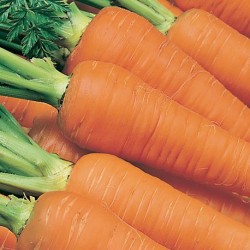



Autumn King produces large roots. Ideal for storing over winter. Well known, easy to grow variety. Carrots are rich in antioxidants and vitamin A. Roots are delicious raw when they are young and great for cookingand excellent for storing too. Approximately 100 days from sowing the carrots to full maturity.
There’s just something about the crunch of a carrot pulled from the ground. You can’t get any fresher than that. Store bought carrots have nothing on homegrown. Fresh garden carrots are crisper, sweeter and more flavourful, because they haven’t been treated with pesticides or chemicals to keep them fresh. If you have never had a freshly pulled carrot, then you’re in for a real treat.
Planting the seeds.
Carrot seeds are tiny, and are slower to germinate than other seeds. As they do not transplant well, it is highly recommended you direct seed them into your garden. Choose a sunny area, preferably with sandy soil. They will also grow in clay soil, but will be more difficult to remove without disturbing nearby plants. Ensure the soil temperature has warmed up to at least 45°F to ensure germination.
In order to utilize space (and mark your carrot rows), you may mix the seeds with radish seeds. By sowing the two together in the same row, you will be decreasing, and possibly eliminating the need to thin your carrots. Plus, you will be able to see just where they are within a few days. Radishes germinate and grow quickly, so by the time they are harvested, the carrots will be emerging from the soil.
To plant your carrots, make a row (or more) approximately half an inch deep in your garden. Gently shake the seeds into it, trying to leave a bit of space between seeds. If you have mixed them with radish seeds, the spacing will be taken care of. You may not get an even alternation of radishes and carrots, but the space created by the radish seeds will generally be enough. For a continuous crop of fresh carrots, you may seed a new row every two weeks until early summer. This succession planting also works for the radishes.
Cover the row with soil, gently firming it down. Water the soil well, using a fine spray. If you use a hard spray or jet stream of water, you will risk washing away the soil and the seeds.
If there is a need to thin, do so during an evening when the air is still. Carrot root flies are attracted to the smell of the foliage being disturbed, so take extra measures to keep them at bay. Burying the thinnings in your compost heap will help mask the smell. Weed regularly, but once again, be careful not to disturb the foliage. You may wish to mulch the soil with grass clippings to keep weeds at bay, as well as conserve moisture.
Carrots also do well in containers, provided the soil is at least twelve inches deep. Use a good quality, loose potting soil. This way it will be much easier to harvest, as there won’t be much room for a garden fork in the container. As your container will dry out quicker, it’s important to keep the moisture level as consistent as possible. Placing containers close together and mulching will prevent them from drying out too fast.
Harvesting your carrots. Your carrots will be ready for harvesting in approximately seven weeks. You may wish to use the ones pulled when thinning, but they can be a little tedious to clean. Depending on the type of soil you have, shorter varieties of carrots can generally be pulled out with ease. If your soil is heavier or the carrots a longer variety, you may need a garden fork to loosen the soil enough to get them out.
For longer term storage, you may wish to consider freezing them or pickling them. To freeze, cut them into chunks and dip into boiling water for a couple minutes, then into cold water (a process called blanching). Place in freezer bags and label with the date. Place in the freezer, and use them throughout the winter in soups, stews or as a side-dish. For pickles, pack clean carrots into a jar with dill, garlic and spices. Pour your favourite brine over them, leaving a half inch of headspace. Place lids on the jars and tighten finger tight. As everyone has different taste and canning knowledge, sources are available at your local library, bookstore or online. You may also find books on canning in your local grocery store where canning supplies are sold.
Wrapping it up. If you have never tried growing carrots before, there’s no time like the present to start. Just remember to plant in loose soil, keep the seeds moist, and don’t thin when it’s windy. You will soon find your homegrown carrots to be much tastier than store-bought ones.